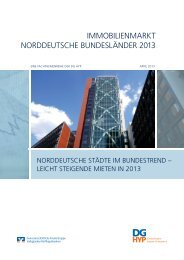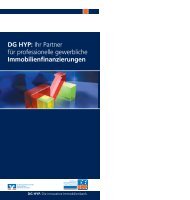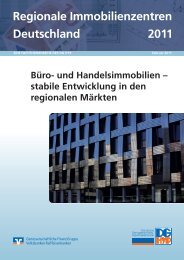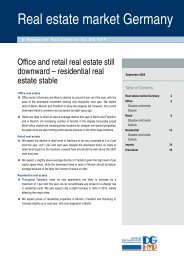ANNUAL REPORT 2006 - DG Hyp
ANNUAL REPORT 2006 - DG Hyp
ANNUAL REPORT 2006 - DG Hyp
Create successful ePaper yourself
Turn your PDF publications into a flip-book with our unique Google optimized e-Paper software.
Management Report<br />
c) Credit scoring/rating<br />
<strong>DG</strong> HYP uses a scoring system to assess and decide on<br />
new business applications in the retail lending business.<br />
Thanks to this process, decisions regarding applications<br />
can be largely automated and therefore conducted in an<br />
efficient manner. Furthermore, risk assessment can be<br />
differentiated in line with a consistent and active business<br />
management policy.<br />
Loan applications are thus assessed in terms of customer,<br />
property and loan product specification, using a<br />
scorecard. A score is calculated for each loan on this basis,<br />
and can subsequently be displayed in a rating class on the<br />
20-level VR master scale that was developed for the cooperative<br />
banking sector. Furthermore, an additional assessment<br />
is carried out through the Strategy ManagementTM<br />
business management system, according to management<br />
criteria applicable to new business (such as loan-to-value<br />
ratio, type of usage, regional aspects). This management<br />
tool is based on a strategy tree, whose parameters can be<br />
adjusted in the event of changes in market conditions or in<br />
response to knowledge gained from the continuous monitoring<br />
of new business from the scenario analyses carried<br />
out. Continuous backtesting of the implemented strategies<br />
ensures targeted management of the retail business.<br />
A continuous assessment of the retail loan portfolio is<br />
performed on the basis of a so-called ‘behaviour scoring’<br />
that can also be displayed in the rating classes of the<br />
VR master scale. This scoring process facilitates a regular<br />
portfolio assessment, which is updated monthly. The bank<br />
can thus identify rating migrations in the retail lending<br />
business at a much earlier stage than was previously feasible,<br />
and take them into account within the scope of new<br />
business and portfolio management as well as processing<br />
the portfolio.<br />
In order to manage the credit risks inherent in commercial<br />
real estate finance, <strong>DG</strong> HYP calculates a credit rating<br />
for the borrower within the scope of the credit analysis,<br />
along with a total property rating (macro/micro location<br />
and property rating) and a loan-to-value ratio for the individual<br />
exposure. The calculated data forms the basis for the<br />
lending decision and pricing. The borrower’s rating, as well<br />
as the property’s ability to cover interest and principal<br />
repayments, is at the forefront of <strong>DG</strong> HYP’s forward-looking<br />
credit analysis.<br />
In order to take the particular demands on <strong>DG</strong> HYP’s<br />
commercial real estate lending business into account, we<br />
also developed (in cooperation with the central institutions<br />
of the German cooperative banking sector and BVR) and<br />
implemented a special Basel-II compliant rating system for<br />
specialised lending (SLRE – Specialised Lending Real<br />
Estate). These rating procedures apply to the following customer<br />
groups: real estate developers, residential property<br />
developers, development companies, closed-end funds,<br />
project developers and commercial real estate investors. In<br />
order to better deal with the specific opportunities and<br />
risks in these customer segments/industries, <strong>DG</strong> HYP introduced<br />
so-called segment guidelines and centres of competence<br />
in <strong>2006</strong>. These bundle detailed industry expertise,<br />
so that specific segment knowledge is actively used in<br />
addition to the regional structure.<br />
For local authority lending, credit ratings are also estimated<br />
based on a rating method that complies with Basel II.<br />
<strong>DG</strong> HYP played a major role in developing the municipal<br />
rating system, particularly within the scope of a cooperative<br />
project where vdp joined forces with S&P Risk Solutions.<br />
We use the VR rating procedures implemented in<br />
DZ BANK within the framework of a ‘rating desk’ solution<br />
for the rating of sovereigns, banks and key accounts.<br />
We use the MoriXTM market and property analysis rating<br />
system, for the purpose of classifying the properties<br />
serving as collateral. For loans in excess of € 400,000 the<br />
MoriXTM results are merged with further estimates of the<br />
property to form a market and property rating by our subsidiary<br />
VR WERT – Gesellschaft für Immobilienbewertung<br />
mbH. This provides major support when the value is surveyed<br />
as part of the preparation of a valuation survey. A<br />
simplified process will be used for loans of less than<br />
€ 400,000, where only the market assessment from<br />
MoriXTM will be taken into account.<br />
As part of the implementation of Basel II, the review of<br />
loan exposure – including a rating update demanded by<br />
Section 18 of the KWG – has been expanded for all<br />
customer categories registered for IRBA. In addition, monitoring<br />
documents are prepared regularly for exposures<br />
exceeding € 2.5 million per primary obligor group. The<br />
monitoring comprises the rating analysis and other<br />
customer records, an assessment of the current rental<br />
situation, and the tenant ratings. The property or other<br />
collateral is revalued if deemed necessary.<br />
Deutsche Genossenschafts-<strong>Hyp</strong>othekenbank AG | Annual Report <strong>2006</strong><br />
37














